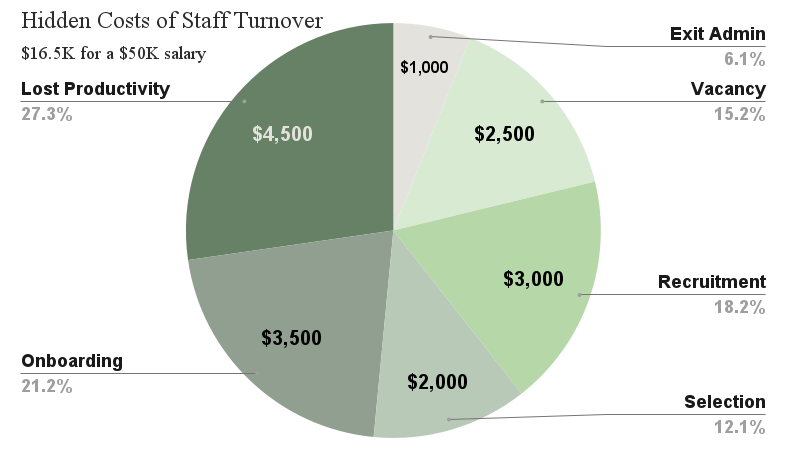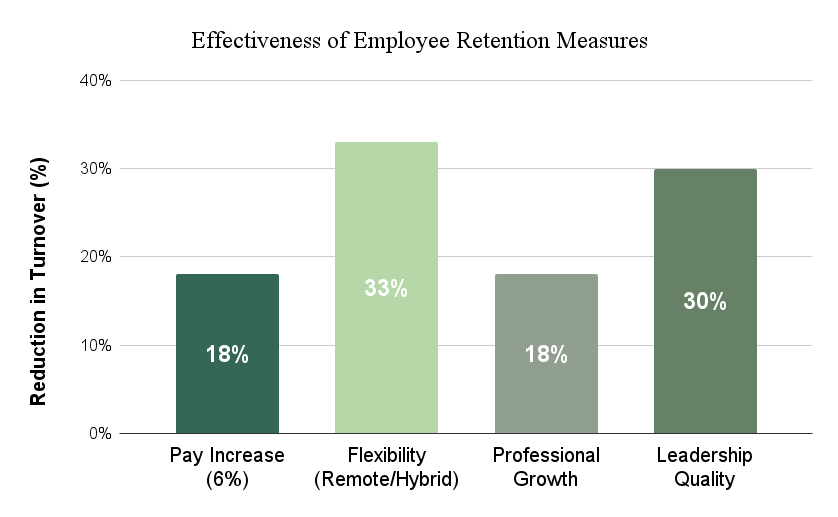The Hidden Cost of Staff Turnover: Strategies for Retaining Your Best Staff Members
Summary:
Administrative staff turnover in independent schools is a costly and under-recognized challenge, often exceeding 33% of an employee’s salary in replacement costs. Core drivers include limited progression opportunities, burnout, low pay, and lack of recognition.
This article outlines actionable strategies to address these issues, including modest compensation improvements, flexible work options, leadership training, and development opportunities. Central to these is the performance review—a frequently overlooked tool that, when used as a two-way dialogue, strengthens leadership, supports staff growth, and significantly improves retention.
By embedding structured, meaningful performance reviews into school practice, leaders can reduce attrition, enhance engagement, and build a more resilient administrative team.
1. The Causes and Costs of Administrative Staff Turnover
Turnover among non-teaching administrative staff in independent schools is often underestimated. Yet, it carries steep financial and operational consequences. Research shows the cost of replacing a single employee is approximately 33% of their annual salary (Work Institute, 2023). For example, replacing a $50,000/year staffer could cost up to $16,500 ($50,000 is representative of a junior administrator, with salaries ranging from $34,000 to over $100,000). This includes recruitment, onboarding, lost productivity, and the loss of valuable institutional knowledge. For senior staff this cost can rise to 200% of their annual salary (Center for American Progress, 2012).
Figure 1 Source: Center for American Progress (2012) & Work Institute (2023)
Several factors contribute to this turnover. Limited opportunities for career progression often leave administrative staff feeling stuck in their roles, with progression rarely occurring through structured organizational bands such as in the corporate sector. In parallel, compensation gaps between private and public sectors persist, making it difficult for independent schools to compete on salary alone, for example in 2017-18 the average salary for public school principals was $98,300 compared to $72,500 for private school principals (NCES, 2018). Burnout also plays a role; administrative staff are frequently expected to wear multiple hats with little support or flexibility. People want to feel seen and appreciated. When staff don’t receive regular, specific feedback or acknowledgment for their contributions, motivation drops. Poorly handled performance evaluations — or no formal reviews at all — can leave employees feeling invisible or confused about expectations. According to research, employees who receive only vague or infrequent feedback are 63% more likely to leave within a year (Textio, 2023).
2. Evidence-Based Strategies to Retain Top Admin Talent
While turnover is costly, schools can take effective steps to retain their administrative staff. Although budget constraints are real, schools should also review their compensation practices. Many schools conduct compensation studies of their market to align compensation rates with competitors, although this can be a laborious process to carry out effectively, even modest salary adjustments and stipends can have a significant impact. A Harvard study found that a 6% increase in pay reduced turnover by 18% (Emanuel & Harrington, 2020). Compensation, however, can be a difficult lever to pull within schools when budgets are exceptionally tight and so schools often have to turn to other low cost methods of improving retention.
Flexibility is increasingly important in today’s workplace. Independent schools have the option to offer remote or hybrid work options for suitable roles or allow for adjusted hours. These small accommodations can significantly improve work-life balance and job satisfaction increasing retention rates by up to 33% (Bloom & Han, 2022). This offering can, however, create tensions within a staff base that cannot all work remotely as this is not possible for teachers and so should be used with caution.
Equally important is the role of leadership. Managers and department heads should be trained not only in operations but in people management—effective communication, recognizing staff contributions, and being alert to signs of burnout all contribute to a healthier workplace. Strong leaders that can identify when they need to intervene and can deploy effective interventions are able to significantly reduce turnover. A study by Waldman, Carter and Hom (2012) found that this kind of leadership reduced actual staff turnover by a meaningful amount and explained about 30% of why people stayed even when they were thinking of quitting.
Figure 2: Effectiveness of Retention Measures
Another critical factor is professional growth and development. Staff members who feel they are learning and advancing are far less likely to seek employment elsewhere, employers facilitating this professional growth can increase retention rates by up to 18% (Dietz & Zwick, 2020). Offering training, cross-departmental exposure, and clear paths for career progression—even in small ways—can make a meaningful difference. Recognition also goes a long way. Regularly acknowledging contributions, whether informally in meetings or through structured programs, fosters a sense of belonging and appreciation. One key tool in facilitating professional growth and development is the performance review, these often overlooked and underappreciated reviews can provide direction for managers in helping their direct reports progress and develop in their professional lives. The next section will examine performance reviews in detail as a tool for employee retention.
3. Performance Reviews as a Tool for Retention
Figure 3 Source: Kuvaas (2006)
Performance reviews are often seen as routine formalities, but they can be powerful tools for staff retention when approached thoughtfully. Research by Kuvaas (2006) highlights a strong link between performance review satisfaction and reduced turnover intentions with potential improvements of nearly 20% in turnover intent. Reviews provide a structured opportunity to reinforce an employee’s value, set developmental goals, and identify and address concerns before they escalate.
To be effective in independent schools, performance reviews for administrative staff must be consistent, fair, and grounded in clear expectations. Reviews should be based on evidence, such as enrollment trends or staff retention, and delivered constructively. Evaluators within schools need training to ensure assessments support growth rather than discourage. Most importantly, follow-ups are key; revisiting goals shows the process is ongoing and meaningful, reinforcing a culture of accountability and continuous improvement.
Beyond performance metrics, the review should be a conversation that strengthens the relationship between the employee and the school. This means creating space for open, two-way dialogue, where the administrator feels heard, valued, and supported. A strong review conversation can signal a commitment to the individual’s development, not just their output. Even for roles without a traditional career ladder, a development-focused review can uncover opportunities for professional learning, cross-functional projects, or mentorship roles, turning a flat path into one of growth and enrichment. These conversations reinforce the message that the school is not just a place of employment, but a community invested in its people.
Performance reviews are not only a sign of effective leadership but also a tool to develop it. When conducted as two-way dialogues, they help managers strengthen core leadership skills like active listening, empathy, and constructive feedback—qualities shown by Waldman, Carter, and Hom (2015) to significantly reduce turnover. These conversations encourage leaders to be more responsive, motivational, and attuned to staff needs. Over time, regular, meaningful reviews foster stronger leadership across the school, supporting both staff retention and a more engaged, capable management culture.
If schools can create an environment that combines the positive impact of high satisfaction with performance reviews, the benefits of effectively supporting professional growth and fostering leadership development, they stand to gain significantly. This multi-focus approach can not only reduce turnover and generate substantial cost savings, but also enhance staff performance and engagement. By aligning meaningful feedback with clear development pathways, schools can build a culture that retains top talent and drives long-term success.
4. Actionable Takeaways for School Leadership
Reducing turnover requires a conscious, sustained strategy. The first step is to understand the scope of the problem. Schools should track turnover rates, calculate the associated costs, and analyze why staff are leaving through exit interviews or surveys. With this insight, leadership can prioritize actions that align with staff needs.
Proactive strategies include introducing more flexible work policies, enhancing opportunities for learning and development, and nurturing a culture of recognition. Compensation should be reviewed with fairness and transparency in mind, even if budgets are constrained. Perhaps most importantly, the role of performance reviews should be elevated. These conversations can shape an employee’s experience and commitment to the school.
Leaders may also consider bringing in external support to refine their performance review processes. Consultants can help tailor evaluation frameworks to reflect school culture and values, ensuring reviews are consistent, motivating, and linked to retention.
By investing in a retention-focused culture—supported by thoughtful performance management—schools can avoid the recurring costs of turnover and instead build a stable, committed administrative team.
References:
Bloom N, Han R and Liang J (2022) How Hybrid Working From Home Works Out. National Bureau of Economic Research.
Boushey H (2012) There Are Significant Business Costs to Replacing Employees. In: Center for American Progress.
Cappelli P and Conyon MJ (2018) What Do Performance Appraisals Do? ILR Review 71(1).
Dietz D and Zwick T (2021) The retention effect of training: Portability, visibility, and credibility. The International Journal of Human Resource Management.
Kuvaas B (2006) Performance appraisal satisfaction and employee outcomes: mediating and moderating roles of work motivation. The International Journal of Human Resource Management 17(3).
National Center for Education Statistics (2018) National Teacher and Principal Survey. National Center for Education Statistics.
Textio (2023) Language bias in performance feedback.
Waldman DA, Carter MZ and Hom PW (2015) A Multilevel Investigation of Leadership and Turnover Behavior. Journal of Management 41(6).
Work Institute (2023) 2023 Retention Report.




